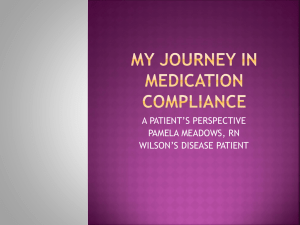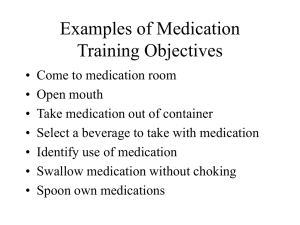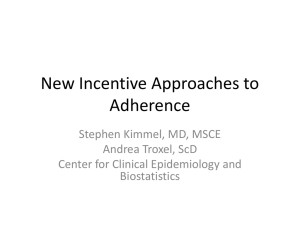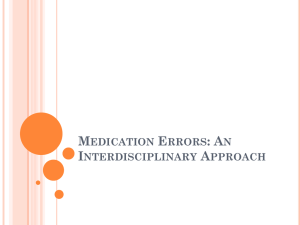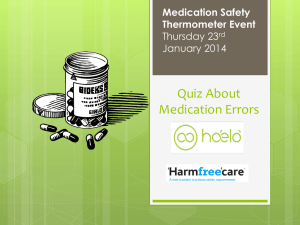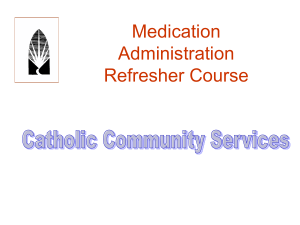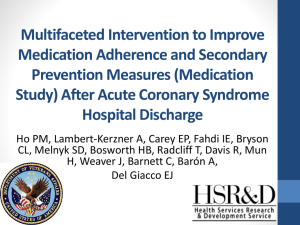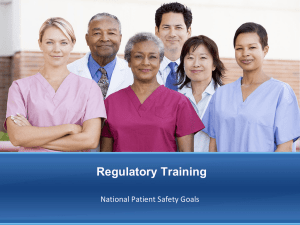Kentucky Home Healthcare Association Nov 2011
advertisement
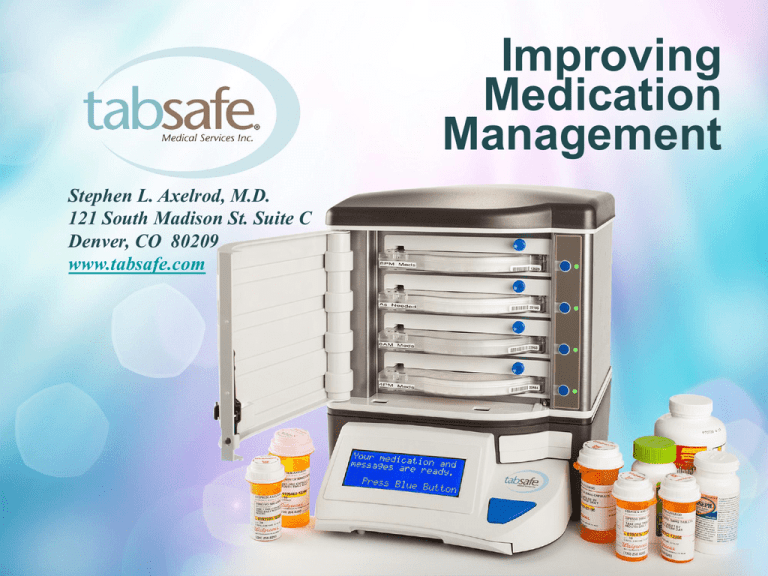
Improving Medication Management Stephen L. Axelrod, M.D. 121 South Madison St. Suite C Denver, CO 80209 www.tabsafe.com “Drugs don’t work in patients who don’t take them.” C. Everett Koop, MD Former US Surgeon General The Growing Problem MEDICATION NONADHERENCE • 51% of all prescription medication in the U.S. is taken incorrectly causing: • 125,000 deaths per year • 1,000,000 hospitalizations • Among the elderly, nonadherence accounts for 30-40% of all hospital admissions Medication Nonadherence RESULTS IN: • 23% of all nursing home admissions •1/3 to 2/3 of all medication-related hospitalizations • An estimated 188.3 MM medical visits wasted because patients do not follow advice received • Increased use of expensive, specialized medical resources How costly is it? How much money is wasted annually in the U.S on the direct and indirect costs associated with medication nonadherence? a. b. c. d. e. $2,500,000,000,000.00 $177,000,000,000.00 $290,000,000,000.00 $258,000,000,000.00 $ 40,000,000,000.00 How costly is it? •Estimated direct costs + •Indirect costs annually1 = $177 Billion 1. National Council on Patient Information and Education. Enhancing Prescription Medication Adherence: A National Action Plan. August 2007. •Estimated direct costs + •Indirect costs annually2 = $290 Billion 2. CVS Caremark, Harvard University, and Brigham & Women’s Hospital. August 2010 •Estimated direct costs + •Indirect costs annually3 3. Express Scripts, Reported in USA Today May 27, 2011 = $258 Billion Demographics “THE SILVER TSUNAMI” Silver Tsunami Demographic Shifts • In the 2000, 35 million people, 13 percent of the population, were age 65 and older - by 2030, 20 percent of Americans, about 70 million people • The population aged 85 and above is the fastest growing segment of the older population • The number of centenarians was about 65,000 people in 2000 by 2030 that is expected to grow quickly so that there may be as many as 381,000 by 2030 Increased Longevity 1900 - 1950 Infectious Disease Breakthroughs: antibiotics, immunizations 1950 - 2000 Acute Cardiac Care Breakthroughs: early dx, CPR, defibrillation, interventional cardiology 2000 - 2030? Chronic Disease Management Breakthroughs: PCMH, patient engagement, EMR, telehealth, medication management Healthcare Continuum • • • • • • • Acute Care Hospitals Subacute Hospitals (LTAC) Skilled Nursing Facilities (SNF) Assisted Living Communities Independent Living Communities Adult Day Care Independent Seniors in the Community SNF & ALF Census 2,000,000 1,800,000 1,600,000 1,400,000 •Number 1,200,000 •of •Residents 1,000,000 800,000 600,000 400,000 200,000 0 1998 2000 2002 Assisted Living •Source – HSG, 7/02 2004 Est Skilled Nursing 2006 Senior Housing Estimates Senior Housing Estimates 86% of Seniors Live at Home About 31% (11.2 million) live alone Med Management Programs Med Management Programs Adherence Technologies Adherence Technologies • Simple pill boxes: Simple medication organizers often designed for seven-day supplies. • Alerts: Telephonic, text, email reminders to take medication at the prescribed times • Complex pill holders with alarms: Medication organizers that also have alarms or alerting for prescribed medication times • Automated Dispensing: An automated dispensing device both prompts the patients to take their medication and dispenses the medication to them. • Monitoring Devices: Monitoring devices provide automated tracking and reporting of a patient’s medication regimen in addition to medication dispersal and reminders. Integrated Technologies “Developed more recently, integrated medication adherence technologies integrate pill dispenser and reminder systems with general health monitoring or health information storage.” Results: Improved mean medication adherence rates of over 92% compared to a 40% baseline medication adherence rate. Technologies for Optimizing Medication Use in Older Adults, Center for Technology and Aging, Sacramento, CA, October 2009. What is TabSafe? ─ Personal medication management system that securely stores medications to be dispensed on a specific time schedule – Medications can be filled by pharmacies, by users, their family members, or home care companies – Sends visual and auditory reminders for medication adherence with verification of completion – 3 follow-up calls to prevent nonadherence – Reminders for activities of daily living and for medications not stored in TabSafe TabSafe is Unique – Manages “As Needed” meds and prevents over-usage – Maintains each medication’s inventory, automatically alerts for reorder, digitally downloads each transaction for reports and analysis. When released, What med, quantity, Who released – Web accessible reports allow for the management of medications from any web browser – Allows for interactive medication dose changes or discontinuance when prescription changes – Collects, records, and correlates vital sign and biometric data to medication adherence data Patented Technology • Patent 7,129,819 B2 Patent issued October 2006 Mechanical design Application software Database software Electrical design Closed-loop Pharmacy Connectivity Vital signs correlated to medication adherence Web-Accessible Reports • Medication Report • Release Report • Inventory Report • Chronic Disease “THE HEALTHCARE TSUNAMI” Incidence of Chronic Disease 1. “20.9% of the population age 60 and older--10.3 million people--have diabetes.” 2. “By 2020, 81,000,000 people will have two or more chronic conditions.” 3. “There are currently 8 million people that suffer from five or more chronic diseases and take ≥ 10 medications.” 1. National Center for Health Statistics. Health, United States, 2005 with chartbook on trends in the health of Americans. Hyattsville, MD: Centers for Disease Control and Prevention. 2005. 2. Partnership for Solutions . Chronic Conditions: Making the case for ongoing care. Baltimore, MD: Johns Hopkins University. 2002 Unrelenting Burden • Blurring Lines in the Accountable Care Era, Fred Bentley, Managing Director, Strategic Research, The Advisory Board Company September 2011 Cost of Chronic Disease • Blurring Lines in the Accountable Care Era, Fred Bentley, Managing Director, Strategic Research, The Advisory Board Company, Sept. 2011 Focus on Reducing Waste • 5% of all Medicare beneficiaries account for 50% of the total Medicare healthcare expenditures • Bottom 50% of Medicare beneficiaries only account for 4% of Medicare healthcare expenditures • 50% of all lifetime healthcare expenditures are spent in the last 18-24 months of life (70-80% irrelevant) • Patients with a Living Will save $5500 on end-oflife care with 70% passing away at home Target Patient Populations • Hospital Care Transition Process • High Risk Patients – Any admission where medication adherence has been identified as a complicating issue – Any hospital discharge for: • Organ transplant • HIV • Schizophrenia • Oncology • Congestive Heart Failure (CHF) • Diagnoses requiring anticoagulation • Pain Management • Frequent emergency transport Reducing Readmissions Care Transitions Interventions (CTI©) • • • • Medication adherence (25-30%) Medication reconciliation (15%) Access to hospital records Physician appointment scheduled within 7 days of discharge • Patient emergency plan • Transition coaching Medication Monitoring and Better Outcomes Medication Dispensing Study Machine Pillbox Hospitalizations per patient 0.09 0.42 ED Visits per patient 0.18 0.42 Prescriptions per patient 7.62 8.65 Buckwalter,KC et al, New Technology for Medication Adherence, Journal of Gerontological Nursing, July 2004, p.5-8 Study Conducted by University of Iowa School of Nursing and Johnson County (Iowa) VNA Greatest success with the medication dispensing system was seen in patients on warfarin therapy or those who had mental and cognitive issues Adherence in AL Released Taken Missed %Adherence Assisted Living* 4802 3414 1388 71.10% AL with TabSafe 312358 310286 2072 99.34% Medication Errors (Missed Med Time) in Assisted Living *Young H, Carley MM, AHCA/NCAL/MECF 58th Annual Convention and Exposition. White Paper: Medication Management in Assisted Living, October 7-10, 2007 TabSafe Improves Adherence Released Taken Missed Independent Guardian TabSafe Customers YTD %Adherence 49.00% 70414 67646 2768 96.07% •Independently Living Individuals Using TabSafe vs. Nat’l Average TabSafe Improves Adherence 100.00% 90.00% 80.00% 70.00% 60.00% 50.00% 40.00% 30.00% 20.00% 10.00% 0.00% Without TabSafe With TabSafe Assisted Living Independent Living Adherence for CHF Patients • Clin Ther. 2007 Aug;29(8):1771-83. • Bagchi AD, Esposito D, Kim M, Verdier J, Bencio D • CONCLUSIONS: State Medicaid agencies and Medicare prescription drug plans should consider designing targeted interventions that encourage better adherence among Medicaid beneficiaries with CHF, particularly men, those aged <65 years, ethnic minorities, and patients with poor overall health status. Reducing Hospital Risk in HIV • Mascolini M. • Conclusion: Regardless of regimen type, people attaining 95% adherence were significantly less likely to get admitted to the hospital. For people taking one pill daily, 6.6% with 95% adherence versus 11.4% without 95% adherence went to the hospital. For the two-pill group, those proportions were 6.6% versus 15.2%, and for the three-or-more-pill group 7.8% versus 12.1%. Proper adherence lowers hospitalization risk by 40% in patients with HIV. Mental Health Hospitalizations • Chris M. Kozma, PhD ; Peter J. Weiden, MD • AHDB. 2009;2(1):31-38 • Conclusion: Small decreases in compliance with antipsychotics are associated with increased hospitalization risk among patients with schizophrenia in a managed care population. Reducing Relapses in Schizophrenia • Ayuso-Gutiérrez JL, del Río Vega JM. • Schizophr Res. 1997 Dec 19;28(2-3):199-206. • Conclusion: Follow-up studies suggest that noncompliance with medication, pharmacological factors, psychosocial factors and alcohol and drug abuse contribute to setting off new psychotic episodes. The most important of these is noncompliance with medication. The overwhelming majority of schizophrenic patients who suffered a clinical exacerbation and required hospitalization (73%) did not comply with the treatment prescribed Coordinated Care Physician/NP Pharmacy Home Healthcare Families Medical Monitoring Coordinated Care • Physician – – – – – Comprehensive patient assessment Evaluate caregiving resources Medication reconciliation “Patient-centric Medical Home” Set parameters and select peripherals needed for monitoring and alerts • Home Care and Home Health – – – – – Arrange for TabSafe and selected peripherals (turnkey) Check exception reports weekly Facilitates caregiving with less labor intensity Monitors adherence proactively and makes follow-up calls Fill medication cartridges where allowed Coordinated Care • Pharmacy – – – – – Manages all medications incl. OTCs Proactive medication reviews Program and fill cartridges Allows for “real-time” medication changes “Pharmacy Home” • Medical Monitoring – – – – – Provide 24/7 call center support Monitor an array of peripherals, e.g. PERs, GPS Data collection, analytics, and reporting Program cartridges for self-filling National distribution and installation Coordinated Care • Families and Caregivers – – – – Facilitates remote caregiving Provides “peace-of-mind” Reduces caregiving burden Monitor medication adherence without intrusive phone calls and controlling behaviors – Allows family engagement • Patient – – – – Utilize medication alerting and dispensing system Maintain their independence Reminders for activities of daily living Provides a sense of self-control Reimbursed Delivery Models • Independence At Home Act – Providing cost-effective care for homebound patients – Utilizes Housecall provider visits • Patient-Centered Medical Home – Proactive care of patients at home • Accountable Care Organizations – Penalties for readmissions – At risk for poor outcomes • Program for the All-inclusive Care of the Elderly • State Medicaid Waiver Programs – Home and Community-Based Services – “Money Follows the Person” programs Continuous Care? • Blurring Lines in the Accountable Care Era, Fred Bentley, Managing Director, Strategic Research, The Advisory Board Company, Sept. 2011 • Blurring Lines in the Accountable Care Era, Fred Bentley, Managing Director, Strategic Research, The Advisory Board Company September 2011 Blurring Lines in the Accountable Care Era, Fred Bentley, Managing Director, Strategic Research, The Advisory Board Company September 2011 1. Adherence matters because physicians are increasingly being held accountable for their patients’ outcomes 2. eRx can identify patients that have not been filling their prescriptions or aid in participant selection 3. Medication dispensing devices, electronic reminders, and follow-up alerts can assist in prompting patients to take their medications as prescribed and improve adherence significantly 4. California has legislated a MDM Pilot with a projected savings of $140MM and 110,000 caregiver jobs annually by utilizing 40,000 units The Bowman Family “Before TabSafe, I was making phone calls twice a day. TabSafe provides peace of mind and freedom for the family. I can go to the movies without worrying about him.” Claudia Bowman Stephen L. Axelrod, M.D. Chairman & CEO TabSafe Medical Services, Inc. saxelrod@tabsafe.com www.tabsafe.com 303.399.1088
